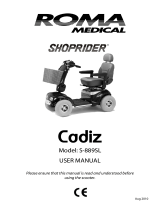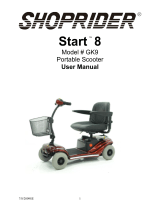InvaMed Shoprider Cadiz User manual
- Category
- Scooters
- Type
- User manual
This manual is also suitable for
InvaMed Shoprider Cadiz is an excellent choice for both indoor and outdoor use. It features a comfortable padded seat with adjustable height and backrest angle, ensuring a tailored fit for each user. The scooter is equipped with advanced safety features such as electromagnetic brakes and a circuit breaker, providing peace of mind while driving. The large pneumatic tires offer a smooth and stable ride, making it suitable for various terrains. With a maximum speed of 12 km/h (8 mph), it allows users to navigate both roads and pedestrian areas safely and conveniently.
InvaMed Shoprider Cadiz is an excellent choice for both indoor and outdoor use. It features a comfortable padded seat with adjustable height and backrest angle, ensuring a tailored fit for each user. The scooter is equipped with advanced safety features such as electromagnetic brakes and a circuit breaker, providing peace of mind while driving. The large pneumatic tires offer a smooth and stable ride, making it suitable for various terrains. With a maximum speed of 12 km/h (8 mph), it allows users to navigate both roads and pedestrian areas safely and conveniently.




















-
 1
1
-
 2
2
-
 3
3
-
 4
4
-
 5
5
-
 6
6
-
 7
7
-
 8
8
-
 9
9
-
 10
10
-
 11
11
-
 12
12
-
 13
13
-
 14
14
-
 15
15
-
 16
16
-
 17
17
-
 18
18
-
 19
19
-
 20
20
InvaMed Shoprider Cadiz User manual
- Category
- Scooters
- Type
- User manual
- This manual is also suitable for
InvaMed Shoprider Cadiz is an excellent choice for both indoor and outdoor use. It features a comfortable padded seat with adjustable height and backrest angle, ensuring a tailored fit for each user. The scooter is equipped with advanced safety features such as electromagnetic brakes and a circuit breaker, providing peace of mind while driving. The large pneumatic tires offer a smooth and stable ride, making it suitable for various terrains. With a maximum speed of 12 km/h (8 mph), it allows users to navigate both roads and pedestrian areas safely and conveniently.
Ask a question and I''ll find the answer in the document
Finding information in a document is now easier with AI
Related papers
Other documents
-
Shoprider 889DXD Owner's manual
-
Shoprider Deluxe S-889NR User manual
-
 Roma Medical Shoprider S-889SL User manual
Roma Medical Shoprider S-889SL User manual
-
Shoprider Cordoba 889XLSBN User manual
-
Shoprider Mobility Scooter User manual
-
Shoprider 889-4XLS User manual
-
Shoprider S-889SL - Cadiz User manual
-
Shoprider FLAGSHIP TE-889XLSN User manual
-
 Roma Medical GK9 User manual
Roma Medical GK9 User manual
-
Shoprider GK9 Start 8 User manual






















